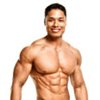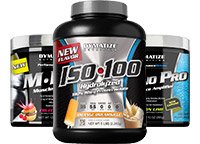I'm a men's physique competitor, so I hear a lot of crap about how we don't train legs. If that's what you think, clearly you haven't taken a look at Craig Capurso's, Alex Carneiro's, or Steve Cook's legs. Despite these excellent examples of how legs should look, there are still many who feel the board shorts are an excuse to skip leg day. If you're one of those sad souls, you need this article.
Why you would skip the workout (i.e., legs) that burns the most calories and naturally produces the most testosterone and growth hormone? Your goal is to build the best physique, but without a solid foundation to stand on, you won't ever be able to reach your potential.
Below are six movements that I rely on to build big, strong legs. If you don't have a normal leg routine, do the movements in the order they're listed. Or, add specific exercises to fill in gaps in your regimen. The rep range should reflect your goals. So, if you're going for strength, do 1-5 reps; hypertrophy workouts will be 6-12 reps, and lifters looking for muscular endurance should do at least 13 reps. For any of these goals, 3-4 sets will be sufficient.
EXERCISE 1 Back Squat
The holy grail of leg exercises, the back squat belongs in your leg routine. Despite what bro science tells you, it is not bad for your knees to go below parallel. When your hip crease is low—below the knee—you have to engage your posterior chain in order to move the weight. Using your glutes and hamstrings instead of relying on your quads makes the lift a more complete leg-training movement.
Depending on your goals, you can either place the barbell across your traps in a high-bar position, or you can place it on the shelf created between your lower trap and shoulder blade in the low-bar position. High-bar squats are also called "Olympic-style" squats and are what you commonly see in the gym. Low-bar squats are used in powerlifting. The lower bar position will change your leverage angles, so you should be able to better recruit your glutes and hamstrings and therefore do more weight.
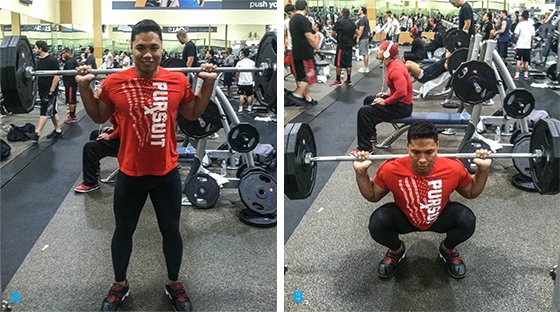
Back Squat
EXERCISE 2 Stiff-Leg Deadlift
This is one of my favorite exercises because I could always do a lot of weight. SLDLs are found in most leg training routines to increase the size and strength of the hamstrings, glutes, and even the lower back. It's also a good movement for increasing flexibility in your hips, hamstrings, and back.
Contrary to popular belief, SLDLs and Romanian Deadlifts are not the same thing. SLDLs begin and with the weight resting on the ground. Most people don't have the flexibility to do an SLDL with their legs "stiff" for the entire rep, so keep some bend in the knee at the beginning of the lift and straighten your legs as you move upward; that's a good way to start. Romanian Deadlifts begin in a hang position and involve pushing the hips back. A rep of RDL ends when your hamstring flexibility reaches is stopping point—for most people, it won't be too far past the knee. When you hit that point, the bar goes back up.
EXERCISE 3 Front Squat
This movement is often left out of many leg routines. It's a more quad-dominant movement, so you probably won't be able to front squat as much as you back squat. Front squats are useful in training your quads (of course), but also help your Olympic lifts, hip and T-spine mobility, and general athleticism.
You can either use a crossed-arms position and hold the barbell across your shoulders with your palms facing down, or use a clean-grip. Neither is right or wrong; it's just a matter of preference. If you're not accustomed to using a clean grip, you may lack the shoulder and wrist mobility to do it correctly.
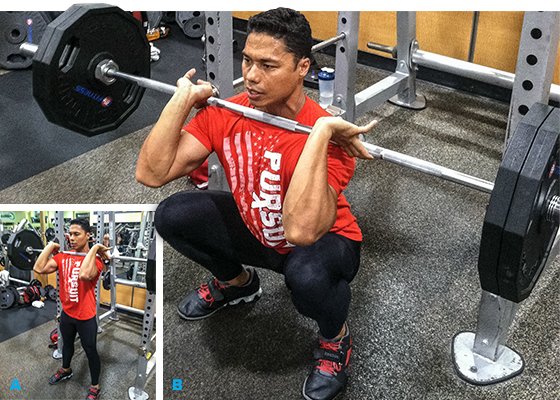
Front Squat
EXERCISE 4 Glute-Ham Raise
I know everyone loves to do leg curls and show off their powerful hamstrings, but the ultimate ham-and-glute exercise is the glute-ham raise. It might seem simple, but using your butt and hamstrings to pull your body weight upward is difficult. If you want strong legs and a powerful rear, this movement is a must-do for your training regimen.
Very few gyms have a machine made specifically for this exercise. If yours does not, your training partner can hold on to the back of your ankles to mimic the effect. Since I train alone, I use the leg curl machine and adjust the leg settings to lock my feet into place, or I jump on the seat used for lat pulls. Most people won't have the strength to do the movement unassisted, so I recommend holding onto a bar in front of you for aid.
EXERCISE 5 Weighted Walking Lunge
Perform the walking lunge properly, and you'll hit your quads and hamstrings, absolutely kill your glutes, and even work your core. This movement is also great for developing flexibility, ankle mobility, and balance. If you're new at this movement, start without weight or a light weight, at least until you're able to do it without breaking from good form.
There are many different ways to hold the weight when doing the walking lunge: use a barbell and hold it overhead, across your shoulders, or in the front-rack position; hold dumbbells on your shoulders or down by your sides; hold a weight plate over your head; or wear a weighted vest.
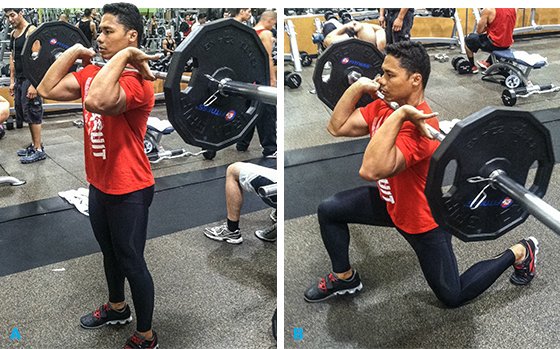
Weighted Walking Lunge
EXERCISE 6 Calf Raise
If calves are a weak point on your physique, I recommend doing both standing and seated calf raises. The seated calf raise primarily works the soleus (the smaller, flat muscle underneath the gastrocnemius) and the standing calf raise works the gastrocnemius (the big, diamond-shaped muscle).To train the entire calf, do both variations.
Change the direction your toes are pointed each set to hit the calves at different angles. The calves are used all day every day, so to force adaption, you're going to have to move some serious weight. As long as you can use a full range of motion, load up!
